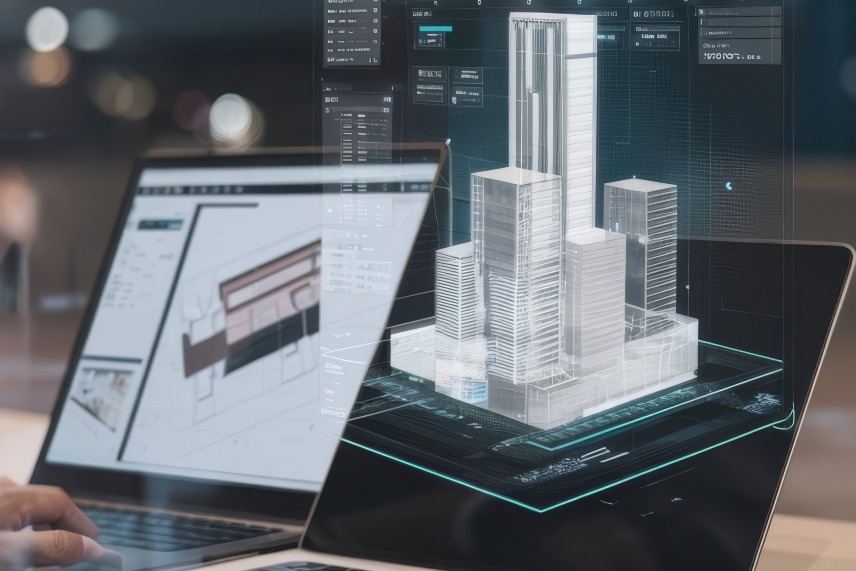- HOME PAGE
- / BLOG
BLOG

BIM and Data Analytics: Transition from Design to Operation
As of 2025, the architecture, engineering, and construction (AEC) industry stands at the heart of digital transformation.
Buildings are no longer static physical entities — they are dynamic systems powered by data.
At the center of this transformation lie two key pillars: Building Information Modeling (BIM) and Data Analytics.
This article explores how BIM processes evolve from design to operation, how data analytics enhances decision-making, and how the concept of the “smart building” is reshaping the future of the built environment.
1. What Is BIM? From Design to Digital Twin
BIM is not merely a 3D modeling method — it is an intelligent information management system that governs every stage of a building’s lifecycle.
It integrates design, construction, maintenance, and operation into a single digital model.
For example, an office building’s window locations, HVAC systems, energy consumption, and maintenance schedule can all be stored and managed within the BIM environment.
The 2025 trend: Digital Twins.
BIM models are now evolving into living digital replicas that connect real-time data from sensors, allowing systems to optimize performance and reduce maintenance costs dynamically.
2. Data Analytics: The Hidden Power Behind BIM
While BIM provides a structural backbone, data analytics transforms it into actionable intelligence.
Massive datasets generated by design, construction, sensors, and user interactions are analyzed through AI-driven algorithms and predictive models.
Through these analyses:
- Long-term sustainability of materials can be evaluated.
- Energy performance can be optimized to reduce carbon footprints.
- Predictive maintenance prevents operational failures before they occur.
- User-centric design improves occupant comfort and experience.
Data has evolved from being a measured outcome to becoming an active design input that guides every decision.
3. Integrating BIM and Data Analytics in the Design Phase
Design today is no longer guided by intuition alone — it is driven by data and simulation.
Architects and engineers utilize BIM-based analytics to perform:
- Energy simulations
- Daylight optimization studies
- Life Cycle Assessments (LCA) for material impact
For instance, the balance between façade transparency and interior thermal comfort can now be precisely calculated in real time through BIM + data analytics integration.
This enables a perfect equilibrium between aesthetics and sustainability.
4. Digital Transformation in Construction: 4D and 5D BIM
By 2025, 4D BIM (time-based) and 5D BIM (cost-based) integration have become industry standards.
Projects are now managed as data-enriched digital frameworks, not just geometric visualizations.
- 4D BIM connects the construction sequence to a timeline, enhancing scheduling accuracy.
- 5D BIM incorporates material and labor costs directly into the digital model.
Project managers can thus forecast budget deviations and take early corrective action.
With the addition of machine learning algorithms, project delays can be predicted before they occur — a revolution in proactive management.
5. BIM’s New Role in Operations: The Age of Digital Twins
BIM’s mission does not end when construction is completed; it becomes the foundation for operational intelligence.
This phase integrates IoT sensors, Building Management Systems (BMS), and energy monitoring tools into a unified digital platform.
Real-time data — including temperature, humidity, energy consumption, and occupancy — continuously updates the BIM model, forming a Digital Twin of the building.
Advantages include:
- Real-time energy optimization
- Predictive maintenance
- Improved occupant safety and comfort
- Up to 20% reduction in operational costs
6. Artificial Intelligence and the Future of BIM Models
As data analytics and AI converge, BIM models are evolving into learning systems.
Machine learning algorithms process historical data to predict future performance and optimize building behavior.
Examples include:
- Automatic lighting and HVAC adjustments based on energy use patterns
- Predictive maintenance schedules informed by component lifecycle data
- Occupancy-based environmental optimization
This seamless data loop connects design, construction, and operation under one intelligent digital ecosystem.
7. BIM’s Role in Sustainability and Carbon Reduction
Sustainable design is no longer limited to material selection — it’s data-driven.
By integrating BIM and data analytics, architects can measure, visualize, and minimize carbon emissions at every stage of the project.
Key tools include:
- Life Cycle Assessment (LCA)
- Carbon Footprint Mapping
- Energy Performance Analytics
The result: buildings that are not only efficient but environmentally responsible.
8. BIM and Facility Management: Intelligent Operation Control
In the operational stage, BIM seamlessly integrates with Facility Management (FM) platforms.
With this connection, facility managers can:
- Track maintenance activities
- Monitor equipment performance
- Access sensor-based building health data in real time
The synergy between Digital Twin and FM systems transforms buildings into data-driven organisms that self-optimize over time.
9. Human-Centered Design: From Data to Experience
Technology is no longer just a tool — it’s a partner in enhancing human experience.
In offices, hospitals, and hospitality spaces, data collected from sensors helps automatically regulate:
- Thermal comfort
- Air quality
- Lighting conditions
This human-centric layer ensures BIM not only enhances efficiency but also promotes wellbeing and occupant satisfaction.
10. Looking Ahead: The Rise of AI-Integrated Ecosystems
The future of design lies in the convergence of BIM, IoT, Artificial Intelligence, and Cloud computing.
These technologies will merge into unified ecosystems where designers, engineers, investors, and users share the same data environment.
This marks a paradigm shift in architecture:
We are entering the era of data-driven experience design, not just building design.
Conclusion
The traditional chain of Design – Construction – Operation has merged into one continuous digital cycle.
BIM and Data Analytics are reshaping architecture, engineering, and operations through efficiency, intelligence, and sustainability.
The goal for 2025 and beyond is clear:
Smart, adaptive, user-centered, and data-driven buildings.





